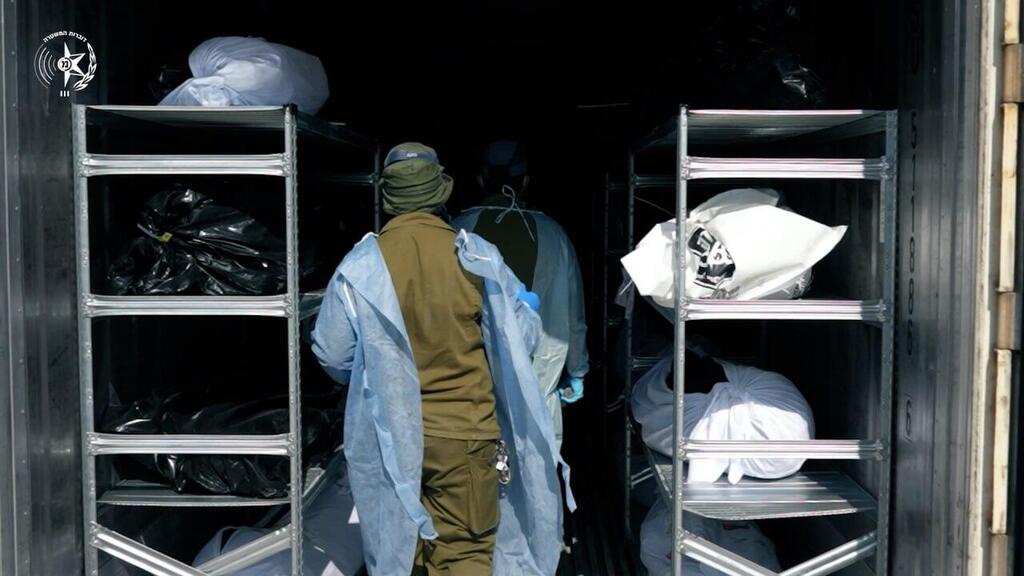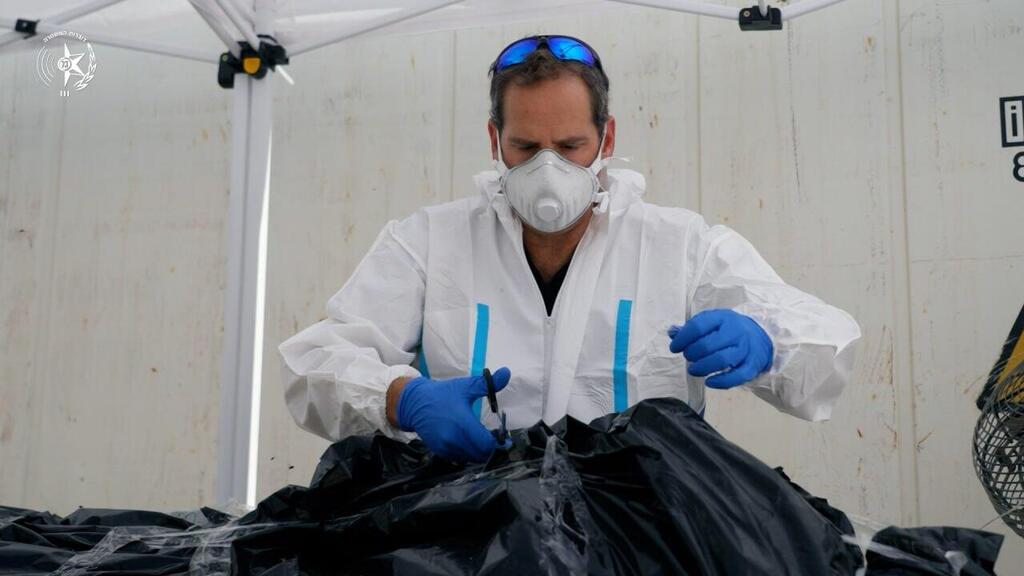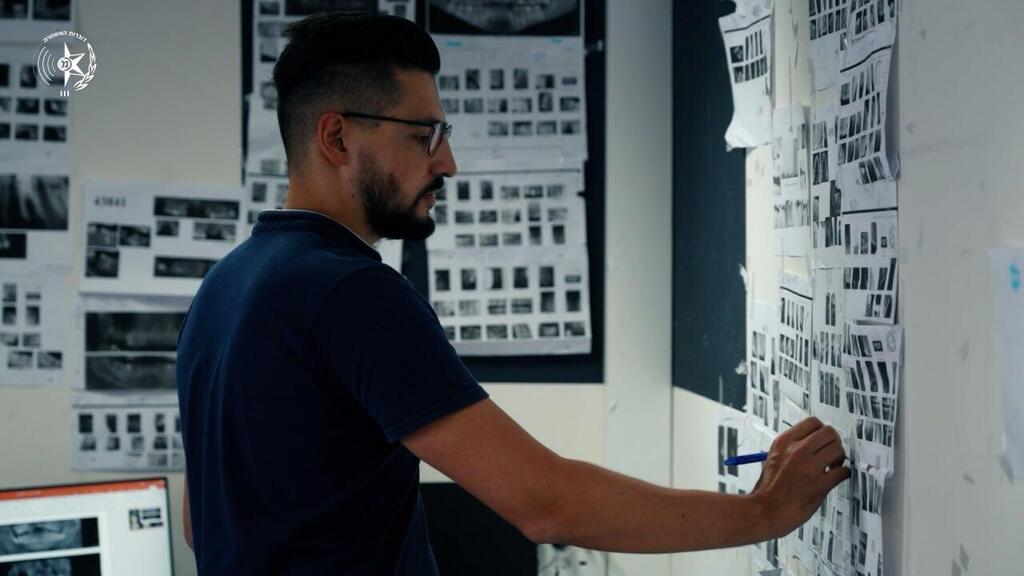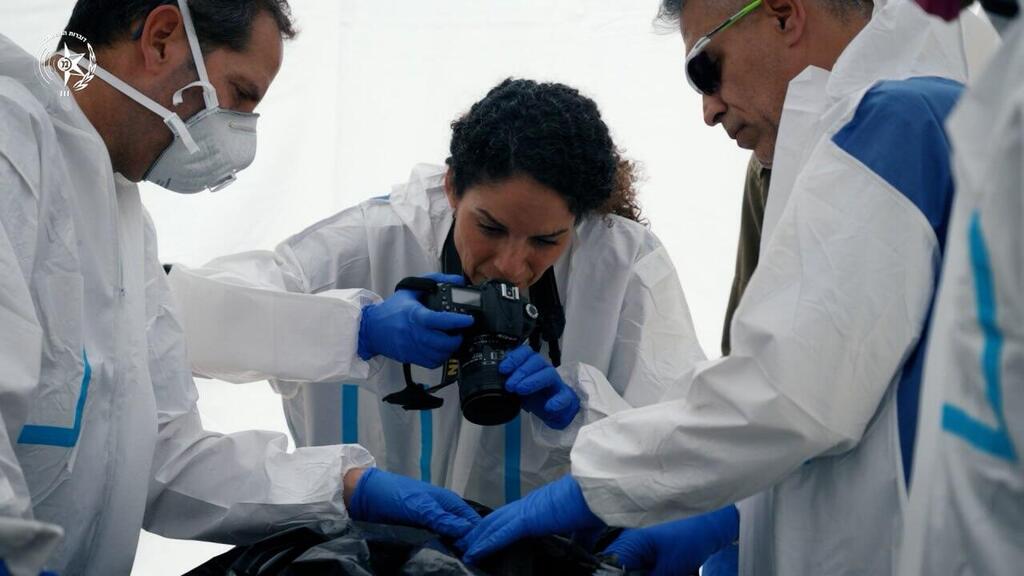In normal times, investigators from the Israel Police's Investigations and Intelligence Division of the Israel Police are the terror of those being interrogated - from government ministers to serious criminals. But for the last nearly two months, the division has been mobilized for a complex and sensitive identification operation like no other at the identification center for the dead at the Shura military base.
Read more:
In the first documentation of its kind published by the police, senior officers talk about the establishment of the complex within a few hours after the Hamas massacre of October 7 and the outbreak of the war, revealing the emotional burden alongside the professional challenge and the sense of mission.
4 View gallery


Police officers on a mission to identify the bodies of civilians in Shura camp
(Photo: Israel Police spokesman's office)
Hundreds of police officers, investigators and intelligence personnel took part in the mission in shifts, 24 hours a day, seven days a week. An identification line of photos, fingerprints, DNA samples, teeth impressions and a collection of objects found on the bodies was established. The shifts were staffed by police officers from the Investigations and Intelligence Division who came from all over the country to work in the difficult conditions, and see horrific sights as more objects are brought in from the field, including body parts and bones.
A few hours after the war broke out in Israel's south, and after the scale of the disaster became clear, the head of the Israel Police's Investigations and Intelligence Division, Superintendent Yigal Ben Shalom, announced the opening of the identification center for the dead at the Shura military base.
"We realized that this was not just another incident, but something much bigger. As the hours ticked by, we realized that the number of victims was many dozens, and as soon as I understood that there are dozens of victims – civilians – I knew we should probably open a center to receive them," according to Ben Shalom.
"Every ring and every piece of jewelry is a person, every mobile phone is a family and every body is a whole world; and, therefore, we have to do everything and return these objects to the families, because this is the only memory that will remain forever for these families."
The police quickly set up three centers, according to Deputy Superintendent Yoav Talem, deputy head of the Intelligence and Investigations Division of the Israel Police. These centers included: a station to which the bodies were brought; an information center for the families run by the Lahav Unit 433; and a center at the national headquarters in the laboratories of the Forensic Identification Department. The department's biometric databases were involved in the cross-referencing of forensic findings.
4 View gallery


Opening the body bag containing a victim of the October 7 massacre
(Photo: Israel Police spokesman's office)
"Our mission was to identify as quickly as possible and as accurately as possible, but accuracy is a priority. That is, fast will not come at the expense of accuracy," Talam said. "God forbid, we would not want to make a mistake such as an incorrect or partial identification and cause a great injustice to these unfortunate families who lost the people most precious to them."
The head of the investigation division of the Israel Police, Shlomit Landes, says that it took time to understand the scope of the work.
"We mobilized the whole division and arrived at the Shura military camp in order to prepare for the process of identifying the victims. Every victim who arrived from the field was taken in, registered, marked and the identification work begins. We did everything to carry out this task in a professional, accurate, fast manner. We saw the families before our eyes and the need to bring answers and bring certainty to people so that they could bring their loved ones to burial."
Aliza Raziel, head of the division of Identification and Forensic Science for the Israel Police, was amazed by the number of bodies that arrived, but she came to her senses very quickly.
"We did not expect and we have not known such a number since the establishment of the state. We were constantly thinking about how we can improve and adopt better identification methods. We found methods to optimize the production of DNA in such a way that we can much more quickly produce profiles and compare them," she said.
The identification procedure, which included frontal, physical and scientific documentation operations, required the deployment of hundreds of the division's police officers who are experts in the fields of investigations and forensics. During the first month of the war with Hamas in Gaza, the division worked at Shura around the clock and in shifts in order to shorten the waiting time of the families who were waiting to bury their loved ones. All the time, more and more victims continued to come from the various disaster scenes.
'Opening the sack, dealing with the sights and smells'
The police investigators witnessed the difficult scenes of bodies that arrived in horrifying condition, some burned or decapitated. Superintendent Roi Bourla from the Investigations Section shared the difficult feelings. "I remember approaching the base here, my pulse went up, I reach the gate and my legs betray me, I really can't walk. And suddenly it hits you, suddenly you see piles of bags. I quickly recovered myself to deal with the task at hand; the forensic scientists were already working quickly, computer tables were already opened, there was incredible preparation here within this chaotic event.
"In the beginning, the quantities were enormous, they were taken in containers from outside and brought into the reception rooms. When the body is placed on an iron bed, the bag is opened, and you are faced with the sights, the smells, the difficulties and the cruelty; fingerprints are taken, DNA samples are taken and photographs are taken. There was indescribable cruelty. In some of the corpses, limbs and heads were missing, corpses sooty to the level of charcoal that it is impossible to recognize."
Superintendent Sharon Cohen from the Investigations Section was also sent to Shura following the murderous terrorist attack. "I was sleeping, my husband came into the room and said to me, 'Sharon, get up quickly, there is an infiltration of terrorists.' It was surreal on another level."
From there it was a short journey to hard work in the Shura camp. "A huge truck stands at the entrance and a convoy of corpses on stretchers enters. An abnormal number, you don't even realize that it's human beings. They bring in corpse after corpse, open the body bags, and each corpse is something completely different. You recognize an outline of a body, you recognize a head, maybe a hand. You don't always recognize the gender of that body, and it is possible that his or her relatives are also lying here in one of the rooms," she describes.
The head of the Department of Forensic Biometrics, Superintendent Uri Argaman, says there were many challenges during the identification process. "We cross-check the data taken from the victims, all the data that could have been taken - fingerprints, DNA, teeth."
Assi Sharon, the commander of the volunteer dentists in forensics, adds: "The dental unit was a significant player in identifying the victims, when it was impossible to use other scientific means."
A photo of the couple, the dog, a life story in a screen saver
When the identification procedure was completed and a scientific opinion was received, the family of the deceased could notified and permission given for the burial.
Bourla shares how, along with the hard work, "this is also a mentally challenging event. There is a very powerful and very traumatic process that the soul goes through. It is a terrible thing. The personal stories of people and also the stories of the police officers who work here - there are heartbreaking events here."
After the identification of the bodies progressed, the difficult phase of calling the families was next.
"We called the families and asked them to come here to try and identify their loved ones, you hold the phone and your tears l," according to Cohen.
4 View gallery


Police officers on a mission to identify the bodies of civilians in Shura camp
(Photo: Israel Police spokesman's unit)
She describes looking through the dead person's belongings to try to find out who he or she was: "Opening a person's wallet and seeing their entire life laid out in front of you. You see the health insurance cards of his children, then you realize that they were murdered together with him. You open the phone, suddenly you see the screen saver with a smile, a picture of a couple, the dog. Life. It's something that enters your soul, you remember the names of these people."
Talem calls the investigators heroes.
"In my eyes, the investigators were the heroes of the hour in the midst of this difficult event that was decreed upon us and forced upon us with dedication and determination; this is a historic role. To come and see how we identify as accurately as possible and if possible as quickly as possible in order to provide comfort, to comfort these families," he said.
He saluted the police officers who took part in the mission, and spoke of its historical importance.
"It's not just to recognize, it's not just to be able to look this satanic evil in the eyes and continue the work. The police have a historic role - you are the new witnesses, you have to tell the people of Israel and the whole world what was done here, what are the horrors without minimizing, without trying to explain - because it is impossible to explain. Human language has not been able to find and invent words to describe the magnitude of the horror that was perpetrated on our people," he said.
In order to reach the end of the identification process in a scientific manner, the police joined with their partners: the Military Rabbinical Corps in the IDF, the National Center for Forensic Medicine, ZAKA, the Interior Ministry, the Health Ministry, the Religious Services Ministry and other government ministries. So far, 860 people murdered on October 7, who are not soldiers, have been identified.



